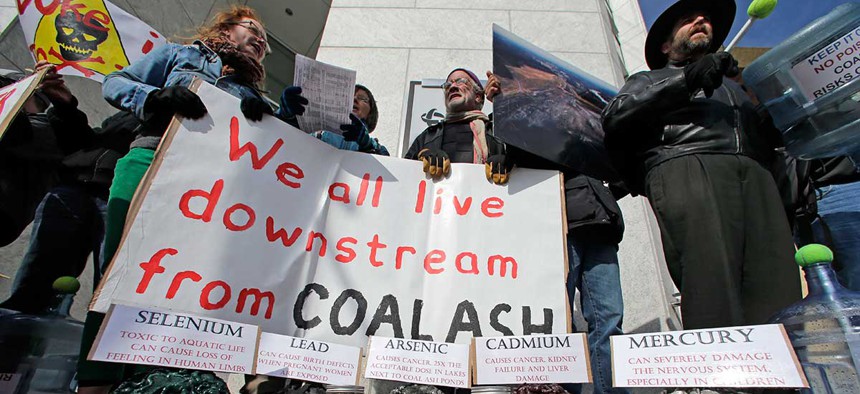
Demonstrators chant and hold signs behind a display of coal ash and the chemicals in it during a protest near Duke Energy's headquarters in Charlotte in 2014. Chuck Burton/AP
The EPA's Failure to Protect People From the Environment
A new report from the U.S. Commission on Civil Rights finds the agency toothless—or even harmful—in addressing environmental justice.
Does the Environmental Protection Agency actually protect communities of color from environmental problems? A new report from the U.S. Commission on Civil Rights suggests it has largely failed that duty:
Since being established in 1993 and having nearly 300 Title VI complaints in its docket, EPA’s Office of Civil Rights has never made a formal finding of discrimination. EPA has never denied or withdrawn financial assistance from a recipient. Despite its regulatory authority to withdraw financial assistance from recipients, the Office of Civil Rights has long “avoided pushing civil rights complaints alleging discrimination based on disparate impact for fear that the agency would lose such a case if challenged in court.”
The Commission took the EPA to task in its compliance report on environmental justice and Title VI of the Civil Rights Act, a regulation prohibiting“discrimination based on race, color or national origin in programs or activities which receive federal financial assistance.” Environmental justice, a term that has risen in prominence since an executive order from President Bill Clinton in 1994 made it an official duty of the federal government, is defined by the EPA as “the fair treatment and meaningful involvement of all people regardless of race, color, national origin, or income with respect to the development, implementation, and enforcement of environmental laws, regulations, and policies.”
Essentially, under Clinton’s order, the EPA has been the lead federal agency responsible for ensuring that fair treatment and meaningful involvement of minority populations in environmental laws, and has also under its Title VI duties been responsible for adjudicating complaints and lawsuits from local communities over environmentally unjust and discriminatory laws and actions by entities—like many local governments—that receive federal funding.
A quick survey of the environmental-justice concerns and unsustained complaints around the country since the establishment of the EPA’s Office of Civil Rights in 1993 illustrates either an impossible standard of proof for adjudication or a complete failure on behalf of the agency. EPA agents were involved early on with the state environmental agency in the debacle that led to the Flint lead crisis, and its Lead and Copper Rule that in theory should have protected children in the mostly-black city of Flint has been criticized by experts, politicians, and city officials alike.
One of the EPA’s few successful involvements in ensuring environmental justice came with the historically-black Rogers-Eubanks community in Orange County, North Carolina, where local officials in 2012 finally acquiesced in providing water and other city services after three decades of using community land for a multi-site landfill complex. Even that victory, however, was incredibly burdensome for the community, as it took not only decades of pollution but multiple rejected EPA complaints before the agency even launched an investigation. The Commission report found 23 pending environmental-justice complaints in the agency’s backlog this year, some from as far back as 2013. A running project from the Center for Public Integrity details the stories of several other communities of color that face extraordinary environmental and health crises but have not been so lucky in bending the agency’s ear.
The Commission on Civil Rights’ report echoes earlier findings from a Deloitte audit of the EPA’s Office of Civil Rights, which found that “the Office has not adequately adjudicated Title VI complaints.” Additionally, its investigation into the agency’s coal ash rule, passed in 2014, found that the rule was not only ineffective at protecting communities of color from racially-disparate siting of hazardous coal ash waste, but actually seems to have violated the spirit of environmental justice itself, as it did not classify coal ash as hazardous, did not involve those communities in the formation of the rule and forces them to bear all of the costs of collecting data and building a complaint about any unjust and hazardous coal-ash disposal.
In short, not only has the EPA been slow and ineffectual in resolving environmental justice concerns in vulnerable communities as dictated by the Civil Rights Act and Clinton’s executive order; it has also passed rules that are perhaps themselves environmentally unjust. Federal environmental protection, for now, still seems to be a privilege of class and race.






